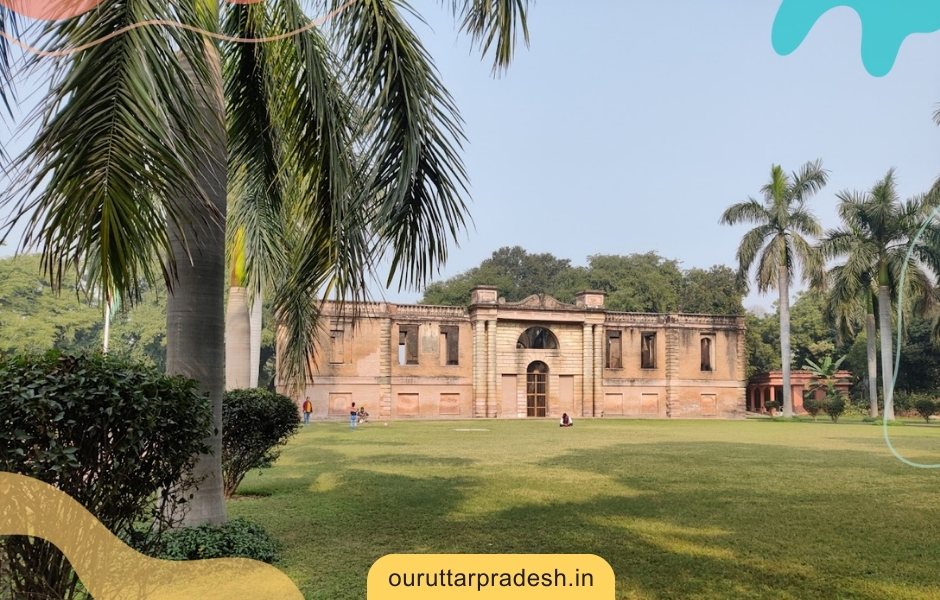Dilkusha Kothi. Also referred to as “English House” or the “Vilayati Kothi,” is a historical site in Lucknow, situated on the banks of Gomti river.
Dilkusha Kothi has witnessed important historical events. Today, it’s not just a popular tourist spot, but its beautiful gardens, known as Dilkusha Gardens, are used for various social events.
The site is an essential part of Lucknow’s history because it has maintained its royal appeal despite its ruin. Even though Dilkusha Kothi might not be the beautiful Kothi it once was, it is still a popular tourist attraction.

History
The historic Dilkusha Kothi in Lucknow has an exciting history of its own as a symbol of glory.
Major Gore Ouseley, a good friend of Nawab Saadat Ali Khan, built Dilkusha Kothi as a hunting lodge for the Nawabs around 1800.
After a while, because Dilkusha Kothi is very close to the river. Begums (wives of Nawabs) also used it as a place to unwind, rest, and have picnics in the beautiful surroundings. It’s worth noting that, unlike other Nawab houses, this Nawab Kothi also didn’t have a separate room for the Begums.

There were some design changes done by Nawab Nasir-ud-din Haider in 1827-1837. Later this, there were some additional adjustments done by Nawab Wajid Ali Shah (the last Nawab).
During his rule, Wajid Ali Shah also constructed a second kothi next to Dilkusha Kothi for military purposes. Britishers don’t want Wajid Ali Shah to do military exercises over there and Britishers forced him to quit all those activities but he doesn’t want to.
As a result, Dilkush Kothi among others like The Residency, La Martiniere School was siege and destroyed by the Britisher Commander-in-chief Sir Colin Campbell in 1857.
The Palace was completely destroyed, and gunshot wounds could be seen on every wall, paying tribute to the brave freedom fighters who gave their lives in the process. It was one of the first wars of independence referred to as the “1857 Revolt” in history.

Architecture
Dilkusha Kothi was constructed in the 18th century by Major Gore Ouseley. This beautiful building was built in the English Baroque style and has an elegant, polished beauty.
Located in the western section of the north-south axis, this building has a special place in the heart of the nawab, which is why it is called “Dilkusha Kothi,” which translates to “Happy Heart.”
Additionally, the Dilkusha Kothi in Lucknow resembles the majestic Seaton Delaval Hall in Northumberland, England.
The Kothi’s unique style is displayed by the supporters around it and is built on a higher platform facing west. Lakhauri bricks are used for its construction and are plastered with limestone.

It is a three-story structure with a mini basement. There were four ornamental octagonal towers, each with painted ceramic tops. The entry to this amazing building was highlighted by a series of steps which led to a central doorway below a massive veranda supported by towering pillars.
To the northeast of this building is another palace built by Nawab Wajid Ali Shah, featuring excellent Indo-European architecture. The two-story castle is also built using Lakhauri bricks and lime cement.
One notable feature of the Dikusha Kothi that sets it apart from other architectural wonders is the absence of inner courtyards, making it truly unique. The position of the female statues near the balconies is another notable feature that contributed to the building’s Claude Martin design.

Present Dilkusha Kothi
Once a beautiful structure, Lucknow’s Dilkusha Kothi suffered significant damage during the siege in 1857 and was turned to ruins by the 1880s. These days, the outer walls and a few towers stand as a monument.
The Archaeological Society of India continues to maintain the surrounding gardens in an excellent manner.

It’s a popular destination, particularly in the winter. It includes young couples and school children having picnics in addition to local families. The normal visitors and foreigners also come to enjoy the location.

Interesting facts of Dilkusha Kothi
- The Construction of Dilkusha Kothi was completed in 1805.
- The literal meaning of Dilkusha Kothi is “Happy heart”.
- British actress Mary Linley Taylor who lived in Seoul, was captivated by the beauty of Dilkusha Kothi and named her own house ‘Dilkusha’ in its honor.
- In November 1857, Sir Colin Campbell, the Commander-in-Chief, took over Dilkusha Kothi with British forces.
Entry fee and timing of Dilkusha Kothi
There is no fee for visiting Dilkusha Kothi and it is open from 8 am to 6 pm. The place is quite large, so it will require at least 1 hour to fully enjoy it.
How to Reach Dilkusha Kothi
- By Airport: The distance between Dilkusha Kothi and Chaudhary Charan Singh Airport is 20.7 km and it takes around 35 min to reach there.
- By Railway: The distance between Dilkusha Kothi and Lucknow railway station is 4.9 km and it takes around 15 min to reach there.
- By Bus: The distance between Dilkusha Kothi and Charbagh bus Station is 5.1 km and it takes around 17 min to reach there.
FAQs
Q1: Who built Dilkusha Kothi?
Ans. It was built by Major Gore Ouseley, a close friend of Nawab Sadat Ali Khan.
Q2: What is the architectural style of Dilkusha Kothi?
Ans. Constructed in the 18th century, this beautiful building is built in English Baroque style.
Q3: Where is Dilkusha Kothi?
Ans. Dilkusha Kothi is situated at Bibiapur Marg, Neil Lines, Cantonment, Lucknow.
Q4: What is famous about Dilkusha Kothi?
Ans. There is no such specific time to visit. But in Janmashtami and Diwali, you found special decorations across the temple.


